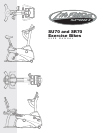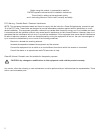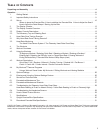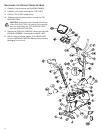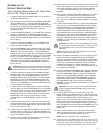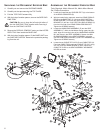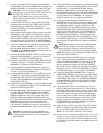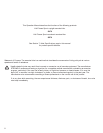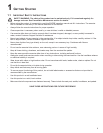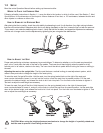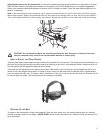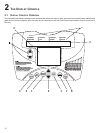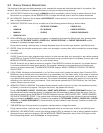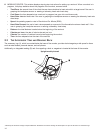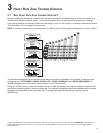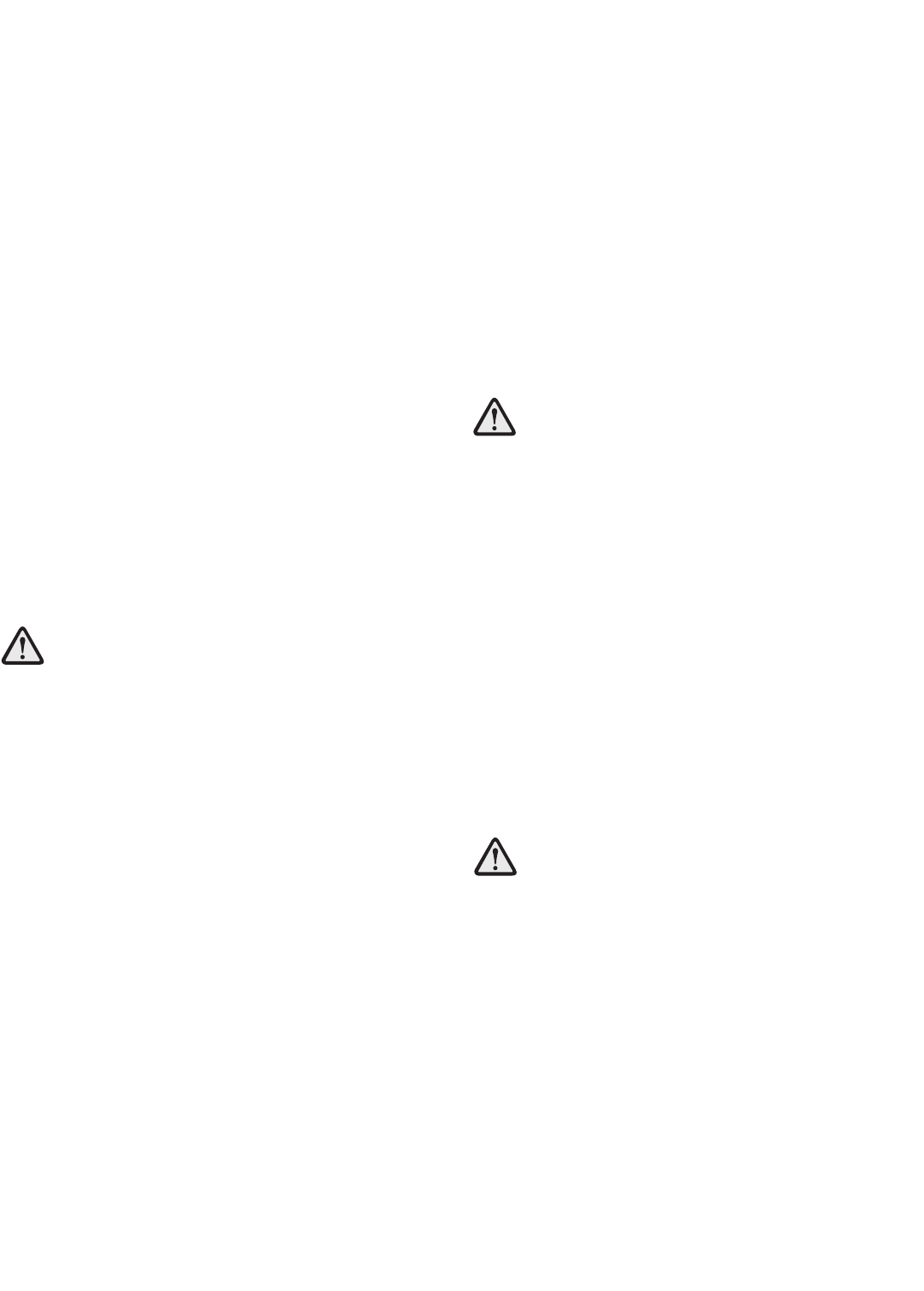
ASSEMBLING THE
UPRIGHT EXERCISE BIKE
Tools Required: Metric Wrench Set, Metric Allen
Wrench Set, Phillips Screwdriver
1. Locate and install the two LEVELER FEET (A) to the bottom of
the REAR STABILIZER (B).
2. With the bends facing rearward, attach the REAR STABILIZER
(B) to the BASE UNIT (C) using two 2-3/8" BUTTON HEAD
SCREWS (1) from the top of the REAR STABILIZER BRACKET
(D) and two 13/16" BUTTON HEAD SCREWS (2) from the front
side of the REAR STABILIZER BRACKET. Tighten the
SCREWS securely.
3. Locate the MONOCOLUMN (E). Cut the WIRE TIE securing the
WIRE (F) to the bottom of the MONOCOLUMN. Slide the
MONOCOLUMN COVER (G) onto the MONOCOLUMN (E) as
shown. Slide the MONOCOLUMN COVER up to the HANDLE-
BAR TUBE (H).
5. Locate and insert the GROMMET (J) into the SIDE ACCESS
HOLE (K) of the MONOCOLUMN (E). Pull the WIRE (F) out
through the SIDE ACCESS HOLE.
6. With the HANDLEBAR TUBE (L) facing the rear of the unit as
shown, slide the MONOCOLUMN (E) into the MONOCOLUMN
BRACKET (M) of the BASE UNIT (C) . Slide the MONOCOL-
UMN down until it is fully seated. Secure the MONOCOLUMN to
the MONOCOLUMN BRACKET using two 3-15/16" HEX HEAD
BOLTS (3) and three THICK FLAT WASHERS (4) (as shown)
from the rear side of the MONOCOLUMN and two 2-3/8" HEX
HEAD BOLTS (5) and THICK FLAT WASHERS (4) from the
user left side of the MONOCOLUMN BRACKET. Tighten the
BOLTS securely.
CAUTION: Be careful not to pinch the WIRE(S) (N) leading
from the MONOCOLUMN BRACKET (M) when inserting the
MONOCOLUMN (E) into the MONOCOLUMN BRACKET.
7. Connect the WIRE(s) (N) leading from the MONOCOLUMN
BRACKET (M) to the corresponding WIRE (F) from the SIDE
ACCESS HOLE (K) of the MONOCOLUMN (E). Slide the
MONOCOLUMN COVER (G) downward to the meet the MAIN
SHROUDS (O). Secure the MONOCOLUMN COVER to the
MAIN SHROUDS using four 1/2" PHILLIPS SCREWS (6) and
matching FLAT WASHERS (7). Tighten the SCREWS securely.
Do not overtighten the SCREWS.
8. Locate the SEAT (P) and SEAT POST (Q). Remove the three
NYLOCK NUTS (8) and FLAT WASHERS (9) from the threaded
studs on the bottom of the SEAT. Align the three threaded studs
of the SEAT with the mounting holes in the SEAT POST
MOUNTING PLATE (R). Secure the SEAT to the SEAT POST
MOUNTING PLATE using the three previously removed
NYLOCK NUTS and FLAT WASHERS. Tighten the NUTS
securely.
9. Locate the SEAT POST CAP (S). With the curved side facing
upward toward the SEAT (P) and the inside notch aligned with
the SEAT POST ADJUSTMENT DECAL, slide the SEAT POST
CAP over the SEAT POST (Q).
10. Locate and slide the SEAT POST SPACER (T) over the end of
the SEAT POST (Q). Using two 1/4" PHILLIPS SCREWS (10),
secure the SEAT POST SPACER to the end of the SEAT POST.
Tighten the SCREWS securely.
11. With the nose of the SEAT (P) facing forward, insert the SEAT
POST (Q) into the SEAT POST SUPPORT (U).
12. Slide the SEAT POST CAP (S) downward to meet the top of the
SEAT POST SUPPORT (U). Secure the SEAT POST CAP to the
SEAT POST SUPPORT using two 1/4" PHILLIPS SCREWS
(11). Tighten the SCREWS securely. Do not overtighten the
SCREWS.
13. Begin inserting the SEAT ADJUSTMENT KNOB (V). Lift upward
on the SEAT (P) and SEAT POST (Q) until the SEAT POST
locks into a position. Tighten the SEAT ADJUSTMENT KNOB
fully. Insert the 1/4" PHILLIPS LOCKING SCREW (12) and tight-
en securely.
14. Locate the ACCESSORY TRAY (W). Position the ACCESSORY
TRAY near the top of the MONOCOLUMN (E) at the DISPLAY
CONSOLE BRACKET (X). While holding the CONNECTOR (Y),
cut the wire tie securing the CONNECTOR to the DISPLAY
CONSOLE BRACKET. Feed the WIRE(s) (Z) leading from the
TOP ACCESS HOLE (AA) of the DISPLAY CONSOLE BRACK-
ET through the center hole of the ACCESSORY TRAY MOUNT-
ING BRACKET (BB). Secure the ACCESSORY TRAY to the
DISPLAY CONSOLE BRACKET using two 5/8" BUTTON HEAD
SCREWS (13) and matching FLAT WASHERS (14). Tighten the
SCREWS securely.
CAUTION: Be careful not to pinch the WIRE(S) (Z) leading
from the DISPLAY CONSOLE BRACKET (X) when securing
the ACCESSORY TRAY (W) to the DISPLAY CONSOLE
BRACKET.
NOTE: Be careful not to let the CONNECTOR (Y) fall into the
DISLAY CONSOLE BRACKET (X).
15. Remove the DISPLAY CONSOLE (CC) from its shipping carton.
Position the DISPLAY CONSOLE above the ACCESSORY
TRAY (W). Connect the WIRE(s) (Z) leading from the DISPLAY
CONSOLE BRACKET (X) to the corresponding JACK(s) located
on the back of the DISPLAY CONSOLE. Secure the DISPLAY
CONSOLE to the DISPLAY CONSOLE BRACKET using four
1/2" PHILLIPS SCREWS (6). Tighten the SCREWS securely. Do
not overtighten the SCREWS.
16. Locate the HANDLEBAR ASSEMBLY (DD). With the handlebars
facing forward, position the HANDLEBAR ASSEMBLY near the
top of the HANDLEBAR TUBE (L). Connect the WIRES (EE)
leading from the HANDLEBAR ASSEMBLY and the HANDLE-
BAR TUBE. Slide the HANDLEBAR ASSEMBLY fully into the
HANDLEBAR TUBE. Secure the HANDLEBAR ASSEMBLY to
the HANDLEBAR TUBE using four 5/8" BUTTON HEAD
SCREWS (15) and matching FLAT WASHERS (16). Tighten the
SCREWS securely.
CAUTION: Be careful not the pinch the WIRES (EE) when
sliding the HANDLEBAR ASSEMBLY (DD) into the HAN-
DLEBAR TUBE (L).
17. Locate the RIGHT PEDAL (FF) (marked with an "R") and
PEDAL STRAP (GG) (marked with an "R"). With the side of the
PEDAL STRAP marked with an R facing upward, slide the slot-
ted end of the PEDAL STRAP through the left slot in the
PEDAL. Fasten one of the slots onto the TAB located under the
left slot of the PEDAL. Bend the PEDAL STRAP upward and
slide the remaining end of the PEDAL STRAP through the right
slot in the PEDAL and into the STRAP ADJUSTMENT CLIP. The
PEDAL STRAP should securely engage the STRAP ADJUST-
MENT CLIP.
18. Install the RIGHT PEDAL (FF) to the USER RIGHT CRANK
ARM (HH). Repeat for the LEFT PEDAL (JJ) (marked with an
"L") and PEDAL STRAP (KK) (marked with an "L").
NOTE: The LEFT PEDAL (JJ) has reverse threads.
19. Position the unit in the desired location for use. The unit can be
easily moved into place by lifting the rear of the unit and rolling it
on the front rollers. Level the unit before use. Refer to the level-
ing instructions stated in the operations portion of this manual.
5



